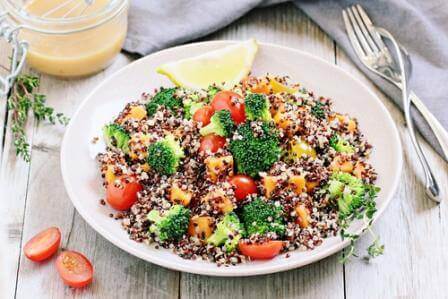Are Saponins in Quinoa Toxic?
Some worry that saponins in quinoa can damage your intestines. But is there evidence to support these claims?

If you look hard enough, you can find some sort of sinister side to every so-called superfood. I guess it was only a matter of time before quinoa got its comeuppance! And sure enough, a quick Google search will lead you to all kinds of scary warnings about the saponins in quinoa.
Some claim that saponins are toxic and that they irritate the intestinal lining, causing inflammation and all kinds of other trouble. But is there evidence to support these claims?
What Are Saponins?
Saponins are bitter compounds that are naturally present in quinoa—along with lots of other foods, including a wide variety of legumes, vegetables, and herbs. They get their name because they lather up in water, like soap suds. In fact, the herb soapwort is one of the most concentrated sources of saponins and can be used to make a natural cleanser.
Like many other phyto-compounds, saponins are produced by plants as a method of natural pest control. The bitter taste of these compounds makes the plant less palatable to birds, insects, and humans.
Although ingesting large amounts of these bitter phytocompounds might cause some stomach irritation or other unpleasant effects, they are generally harmless in small amounts. Even better, these chemicals often have health benefits. In fact, many of the phytocompounds thought to be beneficial to human health fall into this category of “natural pesticides.”
Saponins from quinoa and other plants have been found to have a number of beneficial properties such as binding to cholesterol, neutralizing free radicals, reducing inflammation, and inhibiting the growth of cancer cells. There’s even talk about quinoa as a potential weight loss aid.
Could Quinoa Promote Weight Loss?
A series of studies done on rats, chickens, and piglets found that diets high in quinoa saponins seemed to keep animals from gaining as much weight as they otherwise would. Part of this may have been because the bitter taste of the saponins reduced the amount of food that the animals ate. Something in the quinoa also seemed to increase the secretion of gut hormones that signal satiety or fullness. It’s also possible that the saponins could suppress growth in animals by interfering with intestinal function or nutrient absorption.
However, the studies were done using very high concentrations of saponins.I think the potential for quinoa to promote weight loss (or intestinal damage!) in humans is limited—because the amount of saponins we’re exposed to is relatively small.
The amount of saponins you’d get by eating quinoa is generally much too small to cause any problems.
Saponins are most concentrated in the leaves of the quinoa plant, which we don’t generally eat, as well as on the surface of the grains. The saponins are readily removed by rinsing the grains before you cook them—a lot of brands are pre-washed to save you this step. And much of the quinoa for sale today has been bred to be lower in saponins to begin with, because it gives the grain a sweeter mellower taste and saves you the trouble of pre-washing it. Saponins do not seem to be further reduced by cooking.
Can Saponins Damage Your Intestines?
The amount of saponins you’d get by eating quinoa is generally much too small to cause any problems. However, if you have some other sort of intestinal issues going on, such as irritable bowel syndrome, where your intestines are already inflamed or irritated, it’s theoretically possible that even a very small amount of saponins could further irritate it.
But if you are generally healthy and eating quinoa doesn’t cause any noticeable problems, I don’t think that you need to worry about your quinoa is secretly poisoning you. It is however another great reminder of the value of eating a varied diet rather than eating the same few super foods every day. Eating a variety of fresh foods helps ensure that you’re getting a broad spectrum of nutrients and phytocompounds. It’s also an easy way to avoid over-exposure to a potential hazard.
If you’re eating quinoa several times a week, why not mix things up a bit? Try some other grains like millet, sorghum, farro, or black rice? There are so many fun and interesting whole grains to try, each with unique nutritional highlights. Here’s a Pinterest board I created with a few of my favorite grain-based salad recipes. If you have others that you like, send me the links and I’ll pin them as well!






